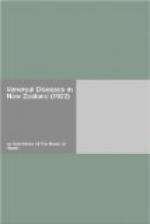(1.) The relaxation of parental control, which was emphasized by many witnesses. Girls stay less at home and assist less in the work of the home, preferring whenever opportunity offers, to go to the pictures or some other form of entertainment.
(2.) Lack of education
of the young in the facts pertaining to sex.
Especially the Committee
would call attention to the unfounded
belief of many that
continence in young men is injurious to health.
(3.) Bad housing and general conditions of living. When members of both sexes are crowded together in restricted accommodation in which often insufficient conveniences are supplied, it is easy to conceive of a relaxation of the proprieties of life which might lead to acts of immorality.
In this connection the Committee desire to call attention to the excellent work done by the Y.W.C.A. and other bodies in the provision of hostels in which girls are provided with board and lodging at very reasonable cost. The Committee were surprised to learn that full advantage was not taken of these provisions, and that the accommodation at these hostels was not fully occupied. It would appear that many girls resent the very slight amount of supervision and restraint exercised over them, precisely as they do parental control.
(4.) The presence in the community of individuals, especially girls, who are to some degree mentally defective or morally imbecile. The Committee were given several individual instances in which such girls had acted as foci of infection; they are easily approached, and facile victims for men. In spite of a degree of mental or moral defect they may be physically attractive.
(5.) Economic conditions which delay marriage may reasonably be regarded as a factor in conducing to an increased frequency of extra-marital sexual relationship. Graph A in the appendix shows clearly that the age of marriage in both sexes has, with slight fluctuations, steadily increased from 1900 to 1921.
(6.) Alcohol tends to the dissemination and persistence of venereal disease: it increases sexual desire, lessens control, causes the individual to be less careful as regards cleanliness, &c., after exposure to infection, and militates against effective treatment. It is to be pointed out, however, that the lower control possessed by some individuals may be the actual predisposing cause, both of laxity in sexual matters and of the excessive ingestion of alcohol. There appears no doubt that alcohol is an important factor in the prevalence of venereal disease, although probably not so potent as represented by some witnesses.
(7.) Accidental infections
are undoubtedly rare. They may arise
from contact with W.C.
seats, dirty towels, and eating and drinking
utensils in public places.




